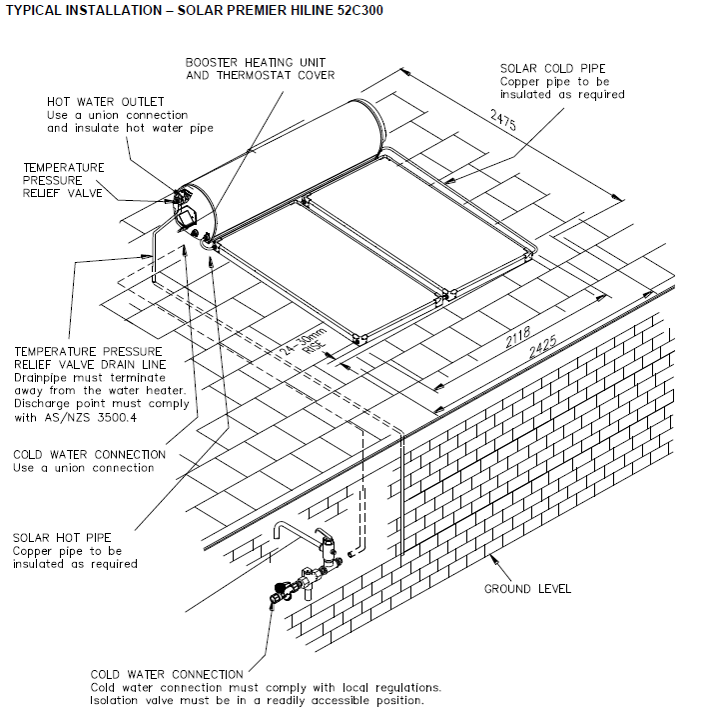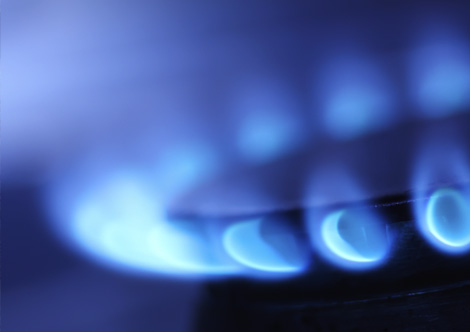
52C300 Roof Top Solar: Key Attributes


Most suitable for areas that receive medium to high levels of solar radiation, and is suitable for frost prone or harsh water chemistry areas.
Show less

Solahart Closed Circuit Systems are protected against freezing or harsh water conditions by our exclusive ‘Hartgard’ fluid. ‘Hartgard’ is used to lower the freezing temperature of the Heat Transfer Fluid and so provides protection against freezing.
Show less

The electric boosted models are equipped with an in-tank element. Alternatively the system can be installed as a pre-heater with an inline Solahart gas booster water heater.
Show less
Key Features
The 52C series solar water heater is an indirect solar hot water system with a heat exchanger wrapped around the inner cylinder as part of the solar storage tank design. The vitreous enamel lined solar storage tank is installed on the roof directly coupled to the solar collectors. This water heater is designed to be installed as an electric boosted solar water heater with its booster heating unit connected to a power supply, however it may be installed with an in-series continuous flow or storage booster.
The solar water heater uses the thermosiphon principle, without the need for a pump, circulator or sensors. The solar collectors absorb solar energy. The low-iron content solar glass allows more solar energy to pass through and be used to heat the collector‟s absorber plate than conventional glass.
- Space saving roof mount design
- Reliable, low maintenance operation
- Energy Efficient – cuts water heating energy use by up to 87%^
- Eligible for Government rebates and incentives
* The suggested price is comprised of RRP less the applicable solar incentive and excluding installation. Solar incentive value applies to 52C300/NPT solar hot water system in Zone 3.
^ Energy savings of up to 60% shown are based on Australian Government approved TRNSYS simulation modelling of a Rheem 52C300/2NPT and using a medium load in Zone 3 and apply when replacing an electric water heater. Any savings will vary depending upon your location, type of Solahart system installed, orientation and inclination of the solar collectors, type of water heater being replaced, hot water consumption and fuel tariff. Maximum financial savings off your hot water bill are achievable when replacing an electric water heater on continuous tariff.
† Rheem Warranty Details: 5/3/1 warranty; 5 year cylinder and collectors supply, 3 year parts, 1 year labour.
52C300 Solar Specifications
| Model | 52C300/2NPT-G | 52C300/2NPT |
|---|---|---|
| Storage Capacity | 300 Litres | 300 Litres |
| Solar Collectors | NPT200 | NPT200 |
| Booster Type | Gas - Remote | Electric |
| Booster Capacity | 26L/min | 150 lt |
| People Per Household | 2-5 | 2-5 |
| Dimensions & Specifications | ||
| Height (A) | 508 mm | 508 mm |
| Width (B) | 2425 mm | 2425 mm |
| Depth (C) | 2475 mm | 2475 mm |
| Collector Depth (D) | 1943 mm | 1943 mm |
| Collector Width (E) | 2094 mm | 2094 mm |
| Collector Height (F) | 83 mm | 83 mm |
| Weight Empty - Tank | 110 kg | 110 kg |
| Weight Full - Tank | 410 kg | 410 kg |
| Weight Empty - Solar Collectors | 72 kg | 72 kg |
| Weight Full - Solar Collectors | 75 kg | 75 kg |
| Electric Boost Specifications | ||||
|---|---|---|---|---|
| Heating Unit Type | Copper sheath immersion element | |||
| Supply Voltage | 220 V - 250 V | |||
| Recovery Rate @ 240 V and Temperature Rise of: | ||||
| Rating kW |
Current Amps |
30°C litres/hour |
40°C litres/hour |
50°C litres/hour |
| 1.8 | 8 | 51 | 39 | 31 |
| 2.4 | 10 | 68 | 52 | 41 |
| 3.6 | 15 | 103 | 77 | 62 |
| 4.8 | 20 | 137 | 103 | 83 |
How Roof Top Solar Systems Work
Solar Operation
52C300 series solar water heater is an indirect solar hot water system with a heat exchanger wrapped around the inner cylinder as part of the solar storage tank design. The vitreous enamel lined solar storage tank is installed on the roof directly coupled to the solar collectors. The heat exchanger and solar collectors are connected by copper pipe work and form a closed circuit which is filled with closed circuit fluid.
The closed circuit fluid is a solution of a blue, non-toxic food grade propylene glycol heat transfer fluid concentrate mixed with water. The heat transfer fluid concentrate is used to lower the freezing temperature of the closed circuit fluid and provides protection against freezing. The closed circuit also provides protection to the solar collectors and solar pipe work against harsh water chemistry.
The solar water heater uses the thermosiphon principle, without the need for a pump, circulator or sensors. The solar collectors absorb solar energy. The low-iron content solar glass allows more solar energy to pass through and be used to heat the collector‟s absorber plate than conventional glass. As the closed circuit fluid gains the sun‟s heat from the absorber, the increase in temperature causes the fluid to rise through the fluid ways and up into the heat exchanger where it transfers its heat into the water in the solar storage tank. This allows cooler fluid from the heat exchanger to flow into the solar collectors to be heated by the sun‟s energy.

Orientation of Solar Collectors
To help maximise system performance, solar collectors should be installed with an optimum orientation facing true north (in the southern hemisphere) or true south (in the northern hemisphere). Always check for true north or true south using a compass or other suitable device.
To help maximise system performance, solar collectors should be installed with an optimum inclination. This is equal to 90% to 100% of the local latitude angle when collectors are oriented within 60° of true north or true south, and between 10° and 20° if the collectors are oriented between 60° and 90° from the optimum orientation. Generally, improved summer performance is obtained from an angle of inclination less than the optimum angle and improved winter performance is obtained by an angle of inclination greater than the optimum angle. If the angle of inclination varies by 20° from the optimum angle, the solar collectors will receive about 10% less total annual solar radiation.

Frost/Freeze Protection
Solahart Closed Circuit Systems are protected against freezing or harsh water conditions by our exclusive ‘Hartgard’ fluid. ‘Hartgard’ is a blue, non-toxic, propylene glycol fluid which, when mixed with water, provides the Heat Transfer Fluid contained in the solar collectors and the heat exchanger jacket around the tank. ‘Hartgard’ is used to lower the freezing temperature of the Heat Transfer Fluid and so provides protection against freezing (Note: for the correct % of Hartgard in the Heat Transfer Fluid, refer to the section on Frost / Freeze Protection). ‘Hartgard’ is a special food grade solution and is the only solution permitted to be used in the closed circuit systems. Hartgard has been approved by the National Health and Medical Research Council of Australia.

Brochures
Why Solahart Solar Hot Water Systems: Download
52C300 Solar Hot Water System Brochure: Download
Solahart In-Line Gas Booster Brochure: Download
Installation Manuals
On-Roof Solar Hot Water System Owner's Guide and Installation Manual: Download
Solahart In-line Gas Booster Owner's Guide and Installation Manual: Download
Solar Incentive Forms
Small-scale Technology Certificate Assignment Form: Download




